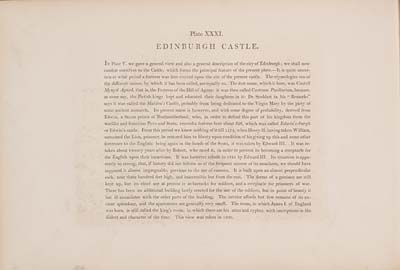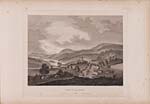(67) Plate XXXI/a
Download files
Individual page:
Thumbnail gallery: Grid view | List view

Plate XXXI.
EDINBURGH CASTLE.
IN Plate V. we gave a
general view and also a general description of the city of
Edinburgh; we shall now
confine ourselves to the Castle, which forms the principal feature
of the present plate.—It is quite uncer-
tain at what period a fortress was first erected upon the site of
the present castle. The etymologies too of
the different names, by which it has been called, are equally so.
The first name, which it bore, was Castell
Mynyd Agned, that is, the Fortress of the Hill of Agnes: it was
then called Castrum Puellarum, because,
as some say, the Pictish kings kept and educated their daughters in
it: Dr. Stoddart in his "Remarks"
says it was called the Maiden's Castle, probably from being
dedicated to the Virgin Mary by the piety of
some ancient monarch. Its present name is however, and with some
degree of probability, derived from
Edwin, a Saxon prince of Northumberland, who, in order to defend
this part of his kingdom from the
warlike and ferocious Picts and Scots, erected a fortress here
about 626, which was called Edwin's-burgh
or Edwin's
castle. From this period we know nothing of it till 1174, when
Henry II. having taken William,
surnamed the Lion, prisoner, he restored him to liberty upon
condition of his giving up this and some other
fortresses to the English: being again in the hands of the Scots,
it was taken by Edward III. It was re-
taken about twenty years after by Robert, who rased it, in order to
prevent its becoming a receptacle for
the English upon their incursions. It was however rebuilt in 1341
by Edward III. Its situation is appa-
rently so strong, that, if history did not inform us of the
frequent success of its assailants, we should have
supposed it almost impregnable, previous to the use of cannon. It
is built upon an almost perpendicular
rock, near three hundred feet high, and inaccessible but from the
east. The forms of a garrison are still
kept up, but its chief use at present is as barracks for soldiers,
and a receptacle for prisoners of war.
There has been an additional building lately erected for the use of
the soldiers, but in point of beauty it
but ill assimilates with the other parts of the building. The
interior affords but few remains of its an-
cient splendour, and the apartments are generally very small. The
room, in which James I. of England
was born, is still called the king's room; in which there are his
arms and cypher, with inscriptions in the
dialect and character of the time. This view was taken in
1800.
Set display mode to:
![]() Universal Viewer |
Universal Viewer | ![]() Mirador |
Large image | Transcription
Mirador |
Large image | Transcription
Images and transcriptions on this page, including medium image downloads, may be used under the Creative Commons Attribution 4.0 International Licence unless otherwise stated. ![]()
| Scotia depicta > (67) Plate XXXI/a |
|---|

